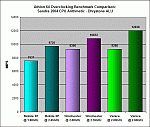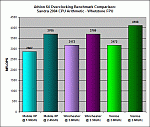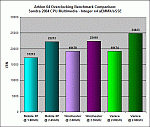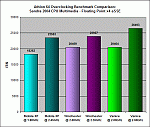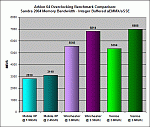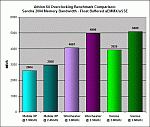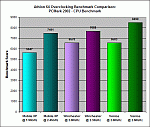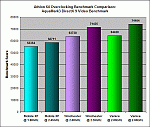| BENCHMARKING PLATFORM & TEST PLAN... |
|
Benchmark testing was performed on a total of three processors. In addition to the two Athlon 64 CPU's, I've also included data for the Athlon Mobile XP 2500+ processor previously in my PC. The testing was performed on my personal PC; system specifications are shown in the table at right. The motherboard, memory and CPU cooler differed for the Athlon XP-M vs. the two Athlon 64's, but all other key components and operating software were common to all the testing. Two sets of data were generated for each of the processors--at default settings and at maximum stable overclock. The Winchester and Venice 3200+ models share the same default settings (10x multiplier, 200MHz HTT for a processor clock of 2.0GHz), so those two sets of data are directly comparable. As discussed previously, the maximum overclocks attained for these two CPU's differ substantially at 2.35 and 2.60GHz respectively, so the OC'ed Venice benchmark results are significantly higher, as expected. One other item of note--the "default" numbers for the XP-M 2500+ processor are not generated at the true out-of-the-box default condition, which uses a 133MHz FSB setting and clock multiplier of 14 for a final processor clock of 1866MHz. Running at these conditions would give an artificially low indication of memory subsystem performance vs. the A64's, which use a 200MHz default memory frequency. Consequently, I set up the XP-M to run at 9.5 x 200 = 1900MHz. This gives directly comparable memory speed to the two A64 default data sets, but keeps the processor speed very close to the true XP-M 2500+ default. For reference, a table summarizing the "as manufactured" specifications of these three processors is shown at right.
The following benchmarks were used to evaluate performance. In the interests of time, I kept the list fairly short, but the mix contains several different CPU and memory tests, plus a popular DirectX 3D video benchmark, Aquamark3. Since the same video card setup was used for all the tests, the results give an indication of how much impact a boost in CPU and memory speeds can give in a 3D gaming simulation. Here's a list of the benchmarks:
- Sisoft Sandra 2004 CPU Arithmetic Benchmarks (3 tests)
- Sisoft Sandra 2004 CPU Multimedia Benchmarks (2 tests)
- Sisoft Sandra 2004 Memory Bandwidth Benchmarks (2 tests)
- PCMark 2002 CPU & Memory Benchmarks (1 test each)
- Aquamark3 DirectX 9 Video Benchmark (1 composite test)
One comment on the Sisoft Sandra 20004 testing: With the exception of one of the CPU Arithmetic tests, SSE2 instruction set support was disabled in the benchmark options while testing the two Athlon 64 CPU's. This was done to force the use of the EMMX/SSE testing mode, so that the results would be directly comparable to those obtained for the XP-M processor.
So, let's move on to the benchmark results and their interpretation....
| BENCHMARKING RESULTS |
The test data for the three processors, at default settings and maximum stable overclock, are summarized in the following table and graphs:
Benchmark Result Summary Table

Benchmark Result Charts
(Click on charts to see full size version)
| ANALYSIS & CONCLUSIONS |
Perusing the above data and charts, I make the following observations/conclusions:
Athlon XP-M vs. Athlon 64 - Though the Athlon 64's are definitely faster, the Mobile XP makes a very respectable showing in the Sandra and PCMark2002 CPU benchmarks. Where it really gets its butt kicked is in the memory tests. Here, the Athlon 64's on-chip memory controller increases bandwidth and reduces latency (i.e. the "waiting time" between when he CPU requests data from memory and when it actually gets it), improving memory subsystem performance substantially. At a memory frequency of 400MHZ (default PC3200 DDR-RAM operating speed), the memory bandwidth for the two A64 processors ranges from 50 - 100% better than for the mobile XP chip, a very significant margin. The Aquamark3 benchmark results give a good overall indication of the Athlon 64's superiority, with the two A64's besting the XP-M processor by about 15% at default speeds and widening the advantage to 22 - 26% when the three CPU's were run at maximum stable clockspeeds.
Winchester vs. Venice @ Default Clockspeed - Not surprisingly, these two sets of results are essentially identical for the CPU benchmarks. What surprised me a bit was that the Winchester processor turned in better memory bandwidth performance, on the order of 3 - 4% higher than the Venice chip. Not a big difference, but consistently higher. It would appear that some of the changes implemented in the Venice to allow more flexible memory management (e.g. using unmatched DIMM's or running at DDR400 speed with all four memory slots filled) may have resulted in a bit of a performance penalty. So if you don't need the Venice's tweaked feature set and you don't plan to overclock, the Winchester could be the (very slightly) better choice for you. But then again, if you're not interested in overclocking your A64, why the heck are you reading this?? Which leads us to....
Winchester vs. Venice Overclocking Potential - In my admittedly limited experience, the Venice chip lived up to its reputation as the better overclocker. As previously mentioned, where the Winchester CPU topped out at 2.35GHz, the Venice made it to 2.60GHz, a full 30% increase over the default clock frequency, and handily achieved the top score on all ten of the benchmark tests. While I'm sure there are examples of Winchesters outdoing their upstart Venice brethren, the result I obtained appears to be fully consistent with the buzz about these two processors. But even with the more modest 17.5% overspeed that the Winchester attained, the performance level attained is very, very good--on a par with Athlon 64 processors selling at well above $300. And an A64 with speed comparable to the Venice chip at 2.60GHz will currently run you almost $500. So you really can't lose when overclocking either one of these A64's!
| THE BOTTOM LINE |
For the upgrader with a mid-range Athlon XP or earlier system who is looking to move to the next level of performance and not go broke doing it, the Athlon 64 3200+ processors offer a very attractive alternative. One of these chips can be paired with a high quality Socket 939 motherboard technology for well under $350 to form the core of a new PC with truly impressive performance for the price. Overclocking these CPU's will further enhance this value and push system performance into the range of significantly more expensive machines. While I also chose to add new RAM with higher performance, I could easily have opted to stick with the PC3200 memory I already had and used the 939 motherboard's memory multiplier settings to keep the RAM running in a stable range. The combination of adjustable HTT frequency plus CPU clock and memory multipliers affords lots of flexibility to optimize overall system performance for your particular mix of components.
As far as which Athlon 64 3200+ to go with, it depends a bit on your circumstance. For most users, I'd definitely recommend the newer Venice core chip based upon its better reputation for overclocking and its enhanced features (SSE3 support, more robust memory handling capabilities). However, if you don't need/want those features and don't intend to overclock your system, the Winchester chip can be found a bit cheaper and my benchmark results show its memory performance to be a bit better. The good news is that, either way, you're unlikely to be disappointed!
June 21, 2005 Questions or comments? E-mail me at THIS LINK |
|


